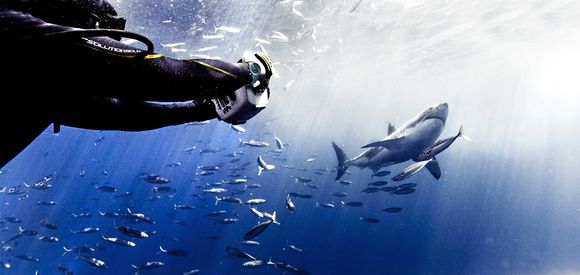
The only thing more varied than photographer —of superstars from Kelly Slater to Lebron James, for blockbusters like Captain America and Spiderman 3, coverage from the Galapagos to Tanzania—is his career path. Muller’s father, Thomas, a project manager who helped build and plan the city of Jubail in Saudi Arabia, used his vacations to take the family globetrotting and practice photography. By high school, the young Muller had traveled to roughly 50 countries and become a whiz with a camera. At 15, he had his first photo published in a snowboarding magazine. At the same time he was calling record labels and pretending to be a photographer for the Contra Costa Times, and shooting the world’s biggest bands as they performed around California. He spent those same high school years training for triathlons. After graduation, he moved to San Diego, climbed into the world top ten, and raced against the likes of Lance Armstrong. Then he did an about face and moved to Boulder to photograph snowboarders, going out 120 straight days to shoot a calendar before passing the reins to his .
In the interest of time, we’ll stop the chronology as Muller hits his early 20s, moves to L.A., and builds that portfolio. With so many famous faces and remote places in his quiver, you might think it would be hard to pick a gallery that stands out. It is, so we went with his latest groundbreaking project, photos of the world’s biggest sharks. Turns out, that many-toothed monstrosity of a project grew out of a simple and innocent childhood prank.
–Joe Spring
Read the interview below or check out Muller’s Great White Sharks Photo Gallery.
What was your first photo?
Actually, the first photo that I took where I saw the power of photography was a shark. When I was in fourth grade, I took a picture of a shark in a National Geographic. So I had a photo of a photo and I was showing all of my little buddies. And they were like, Oh, no way. You saw a shark. I lied to them for like 20 minutes, until the guilt just ate me up. Then I was like, Nah, I’m just kidding. I took a picture of a picture of a shark. But I saw how excited they were and it always left an impact on me.
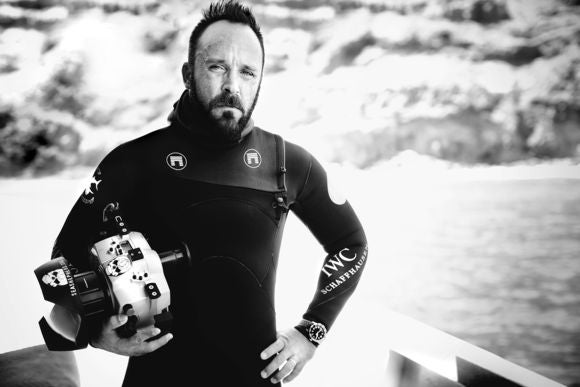
How did you get into underwater photography?
The underwater really came about eight years ago when I started doing the Speedo campaign. Speedo had been using the same photographer about 15 years. The president of Speedo loved this guy. He [the president] retired. The minute he retired, the young guns were on a worldwide search to hire someone new. It was a real big search. I remember seeing photographers sending in books. So I told my agent at the time, I want to get this job. This is my job. This is me. We put together the books. I hadn’t really done a lot of underwater photography at that point. So I didn’t have a lot to show there. But what I did do—I got my newspaper clippings out of my triathlon stuff. For the majority of my career I was sponsored by Arena swimwear. I had 15 sponsors when I did triathlons, but I got the clippings out and started reading them, and one of them was when I was at the world championships and it listed my sponsors. That year I had a deal with Speedo, and so I circled it and sent it to my agent. Send this to them. I know swimming. I know it. I can do this. And so I landed the job. That started a real journey of seven years shooting with them—through two Olympics—and trying every sort of lighting that was available. HMI lights, strobe lights, everything. That led me to inventing one of the most powerful underwater strobes in the world—which I have now.
Tell me a bit about those strobes.
We wanted to bring the studio underwater. Or, I wanted to bring the great white into the studio, right? So I started looking to find some good strong lights. And you know, they didn’t exist. And I was like, Oh, OK. So I set out and started meeting people and getting ripped off and having people build stuff that didn’t work and almost gave up. Then I hooked up with these two guys. And they said, Here’s a solution. And now I have 1200-watt waterproof strobe lights.
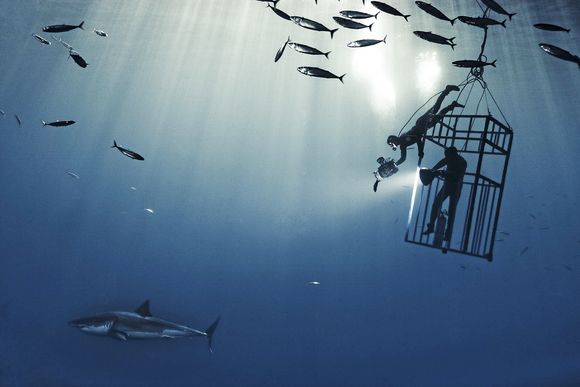
And how do those work?
They’re just waterproof heads. The actual strobe light is a light, we just built the housing and the way to make it waterproof. We have a patent pending on that. And so I have an assistant up on the deck of the boat or the side of a pool and he controls all the packs, and I have two to six assistants underwater holding the lights, and I have a communication system so I can talk to my guys underwater and they can hear me and I can direct them. And we do that with people, I just did it yesterday for ESPN magazine, shooting this long-distance swimmer.
So why was this system originally put together?
For my passion, it was to shoot great whites. Commercially, it was for Speedo and IWC and the other underwater campaigns that I do. And also, to put them out on the market and change the way underwater photography is done.
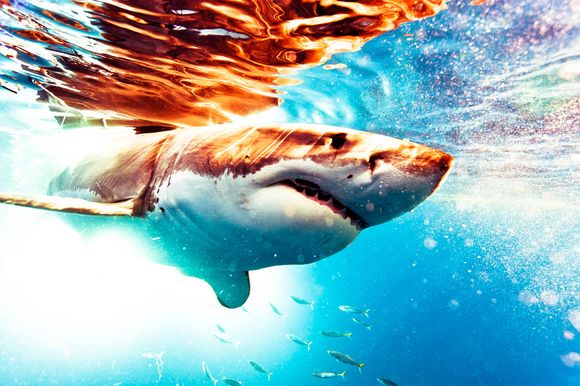
How can someone tell the difference between your photo of a great white shark and another photo of a great white shark?
Well, without a doubt by the lighting of it and the look of it, and maybe the details. They look surreal. Sharks swimming out of light? You don’t see light behind sharks. That means somehow someone got some light behind them, or up close.
When did this start?
I think a lot of it is because I stopped when I was in the Galapagos. The day the lights were delivered was the day before I left for the Galapagos to do an IWC watch campaign in conjunction with the Charles Darwin Foundation and UNESCO. There was a big emphasis on conservation. And when I was down there I just had a sense of fulfillment and purpose. I was like, This is what I want to do. This is what I need to do. And I sort of reflected on that. I take other photographs to help sell movies, and most movie posters I do help sell $100 million at least. They do really well—people go to them—and part of that process is the marketing and the one sheet and the trailer to get people in the theater. I know that I have a gift, and I have seen what is happening to our planet. I have three daughters who might not be able to see these animals in 10 to 15 years. They’re going to be gone, and I want to try to document them and help them. So, if I can take a photo of a shark or a stingray or a dolphin or a whale and people can look at it, and maybe look at it in a way that they haven’t seen before, and say, Wow, this is beautiful. What can I do? How can we save this? Or, How can we change what’s happening? That’s sort of my mission right now.
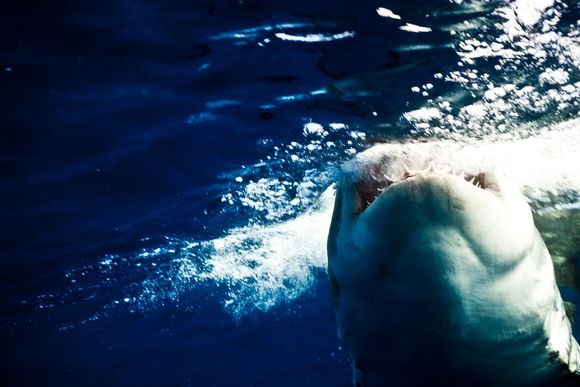
When your shooting sharks, is there something you’re trying to capture?
I think it’s a combination of the lighting and the moment—the behavior. Most people catch them breaching from the surface when they’re shooting out of the water. I have them breaching from underwater in a 16-time sequence, a shark leaving the water and then reentering the water. I have two great whites posting up nose to nose to see who is bigger, to get the food. I’ve never seen that before. I have four great whites in one shot, six great whites in another. I’m definitely going for shots that I haven’t seen before, but they’re animals. I have no control over what they give me and what they do for me, which is great. Whereas, when I shoot people I control the situation for the most part—from telling them where to stand to where to look. For the animals, they’re dictating me. I have to adapt to them. I have got to adapt to their behavior, because they’re always changing. They’re not going to come to the same place. They’re not going to hit their marks. So my guys holding the lights, myself, we have to be constantly adapting and evolving to the situation. There are a lot of dynamics going on. Lights, cables, and a bus with teeth swimming around that you have to keep your eye on. It makes for, without a doubt, the most challenging photo shoots I’ve ever done.
And do you have one shot that you consider your toughest shot?
I don’t have one particular shot, but I will say this shoot I did a month and a half ago with tigers and bulls. Shooting sharks at depth—60, 70, 80 feet—with lights is really challenging. It’s not like one shot where I got one shark doing this. You know what I mean? And that’s sort of true with all of my photos. I don’t have a favorite photo. As a photographer I have attachments to each image. Not the one photo, the experience of getting the photos is the challenge or the thing.
Do they react to the huge strobe lights at all?
No, they don’t. They couldn’t care less.
I just can’t imagine the prep time that must go into one of your shoots, with all of the dive gear and tech gear.
There’s a lot, and I gotta say, I couldn’t do it without my team. My guys. I mean they’re not assistants. They’re a team. They are second to none. They’re phenomenal. They’re smart. They think off the top of their head. What’s that word? Ingenious with how they get things done. They overcome problems or issues that come up. They’re fearless. I’m that way with sharks, but they’ve had to overcome a lot of their fears because they’re following me into these situations. I’m like, C’mon, you have nothing to worry about. Someone’s got to hold these lights, figure out how to get these lights down to 70, 80 feet. There’s a lot of prep and a lot of planning that goes into that. Ricky Ridecos, Blake Farrington, Leland Hayward, Keith Leman are my core that help me to achieve these images. I have gotten them all rescue certified. None of them were divers before they started working with me.
How did you break that to them? They’re on the set of movies and now they’re going to shoot sharks?
My team’s been with me for, many of them, 10 years. Pretty much my career since I moved back to L.A., and they love the adventure. Between the movie posters and the sharks, it’s not the same thing week in and week out. One week we’re on the top of a mountain in New Zealand, and the next week we’re in the Galapagos, and the next week were with the president somewhere, and then were on the set of a huge movie. Who wouldn’t want to do that? So when I said we’re going to shoot sharks, they were like, Let’s do it.

And so if there’s one thing you hope people get out of these shark photos, what do you think that will be?
My images of sharks are done purely so that people realize that 70 million—not 7 million— are slaughtered every year, for a soup, a delicacy. They are at the top of the ecosystem, and you take them out? It’s a domino effect. The collapse that’s going to happen is going to be felt in the oceans. And I just hope that people see the photos and maybe get educated in a little way about what’s happening. And that they realize they don’t have to be scared of them. There were or three fatalities last year in the whole country. I want to say there were five or worldwide. But I want to say that there were 140 people that died from bees. People don’t need to be sacred. I tickle sharks. I do, when they swim by.
is working with the on a show about his innovative shooting methods. One episode will cover his expeditions photographing sharks.